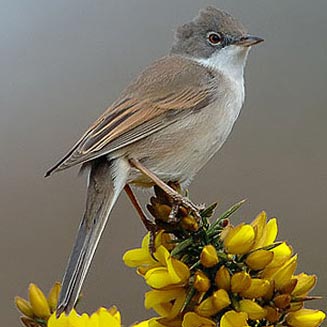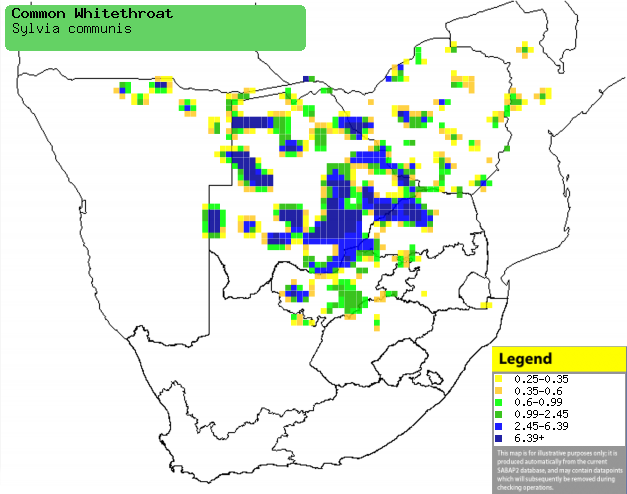|
Sylvia communis (Common
whitethroat)
Witkeelsanger [Afrikaans]; Niini/Hamanku niini [Kwangali];
Timba (generic name for cisticolas and warblers) [Shona]; Grasmus [Dutch];
Fauvette grisette [French]; Dorngrasmücke [German]; Papa-amoras
[Portuguese]
Life
> Eukaryotes >
Opisthokonta
> Metazoa (animals) >
Bilateria >
Deuterostomia > Chordata >
Craniata > Vertebrata (vertebrates) > Gnathostomata (jawed
vertebrates) > Teleostomi (teleost fish) > Osteichthyes (bony fish) > Class:
Sarcopterygii (lobe-finned
fish) > Stegocephalia (terrestrial
vertebrates) > Tetrapoda
(four-legged vertebrates) > Reptiliomorpha > Amniota >
Reptilia (reptiles) >
Romeriida > Diapsida > Archosauromorpha > Archosauria >
Dinosauria
(dinosaurs) > Saurischia > Theropoda (bipedal predatory dinosaurs) >
Coelurosauria > Maniraptora > Aves
(birds) >
Order: Passeriformes > Family: Sylviidae
> Genus: Sylvia
 |
|
|
Common whitethroat, Suffolk, England. [photo
Andy Bright
©] |
|
Distribution and habitat
Its breeding grounds are from western Europe to north-west
Africa and Mongolia; in the non-breeding season it heads south to sub-Saharan
Africa, occurring in a band from Senegal to Ethiopia south to southern Africa.
Here its distribution is centered around Botswana, extending into Zimbabwe,
northern South Africa and north-eastern Namibia. It generally prefers arid
woodland with scattered Acacia trees, or with miombo (Brachystegia)
and Zambezi teak (Baikiaea plurijuga), especially with undergrowth
containing fruit-bearing shrubs.
|
 |
|
Distribution of Common whitethroat in southern
Africa, based on statistical smoothing of the records from first SA Bird
Atlas Project (©
Animal Demography unit, University of
Cape Town; smoothing by Birgit Erni and Francesca Little). Colours range
from dark blue (most common) through to yellow (least common).
See here for the latest distribution
from the SABAP2. |
Movements and migrations
It mainly arrives in southern Africa from late
November-December, departing from March-April.
Food
It eats a variety of insects and fruit, often foraging
solitarily but also joining mixed-species foraging flocks. The following food items have been recorded
in its diet:
- Insects, e.g. midges
- Fruit
- Salvadora (mustard tree)
- Morus (mulberries)
Threats
Not threatened.
References
-
Hockey PAR, Dean WRJ and Ryan PG 2005. Roberts
- Birds of southern Africa, VIIth ed. The Trustees of the John Voelcker
Bird Book Fund, Cape Town.
-
Harrison, J.A., Allan, D.G., Underhill, L.G., Herremans, M.,
Tree. A.J., Parker, V. & Brown, C.J. (eds). 1997. The atlas of southern
African birds. Vol. 2: Passerines. BirdLife South Africa, Johannesburg.
|
